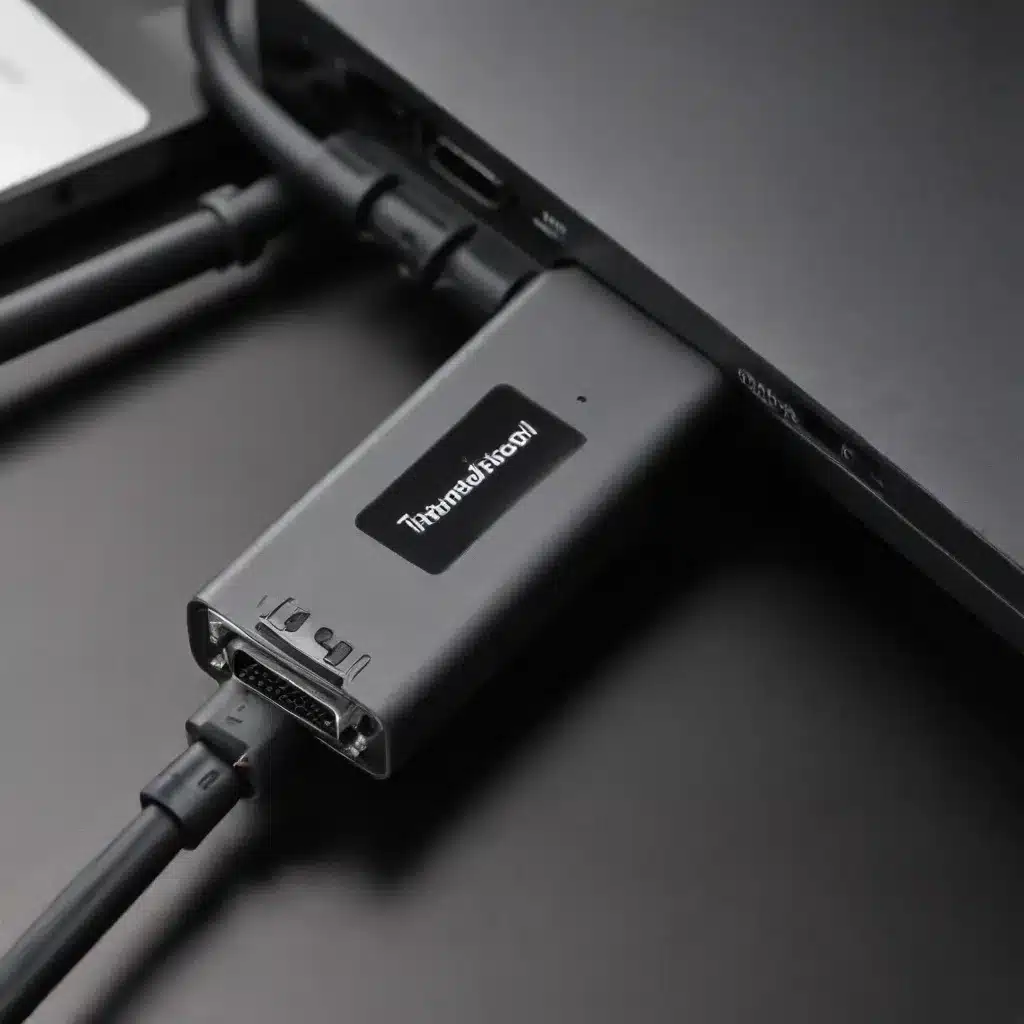
Understanding Thunderbolt 3 Connectivity
Thunderbolt 3 is a powerful and versatile connectivity standard that has revolutionized how we connect devices to our laptops. With its ability to transfer data, provide power, and support high-resolution displays, Thunderbolt 3 has become a go-to solution for IT professionals and tech enthusiasts alike.
One of the key features of Thunderbolt 3 is its compatibility with DisplayPort, a widely-used video interface for connecting displays to computers. This integration allows Thunderbolt 3-equipped laptops to seamlessly connect to a wide range of external displays, including high-resolution and high-refresh-rate monitors.
Thunderbolt 3 vs. USB-C: Distinguishing the Differences
While Thunderbolt 3 and USB-C share the same physical connector, it’s important to understand the key differences between the two. Thunderbolt 3 offers significantly more bandwidth, with a maximum data transfer rate of 40 Gbps, compared to USB-C’s 10 Gbps. This higher bandwidth enables Thunderbolt 3 to support more demanding tasks, such as driving multiple high-resolution displays simultaneously.
Additionally, Thunderbolt 3 provides up to 100W of power delivery, allowing it to charge laptops and power external devices more efficiently. In contrast, USB-C’s power delivery is capped at 20V/5A, or 100W.
Connecting Displays with a Thunderbolt 3 to DisplayPort Adapter
When it comes to connecting displays to your Thunderbolt 3-equipped laptop, a Thunderbolt 3 to DisplayPort adapter is a popular and effective solution. These adapters leverage the Thunderbolt 3 interface to convert the signal and allow you to connect your laptop to a DisplayPort-enabled monitor or projector.
Advantages of Using a Thunderbolt 3 to DisplayPort Adapter
-
Versatility: Thunderbolt 3 to DisplayPort adapters are compatible with a wide range of DisplayPort-enabled displays, making them a flexible choice for various setups.
-
High-Resolution Support: These adapters can handle resolutions up to 8K at 60Hz or 4K at 120Hz, ensuring that your displays can take full advantage of your laptop’s capabilities.
-
Daisy-Chaining Displays: Many Thunderbolt 3 to DisplayPort adapters support daisy-chaining, allowing you to connect multiple displays in succession, simplifying your workspace setup.
-
Power Delivery: The Thunderbolt 3 interface can provide up to 100W of power to your connected devices, eliminating the need for additional power cables.
Selecting the Right Thunderbolt 3 to DisplayPort Adapter
When choosing a Thunderbolt 3 to DisplayPort adapter, consider the following factors:
- Resolution and Refresh Rate: Ensure the adapter can support the desired resolution and refresh rate of your display.
- Compatibility: Check that the adapter is compatible with your Thunderbolt 3-equipped laptop and the specific DisplayPort version of your display.
- Power Delivery: Look for adapters that provide sufficient power delivery to charge your laptop while in use.
- Brand and Reputation: Opt for adapters from reputable brands known for quality, reliability, and customer support.
Step-by-Step Guide to Connecting a Display with a Thunderbolt 3 to DisplayPort Adapter
- Connect the Adapter: Plug the Thunderbolt 3 end of the adapter into your laptop’s Thunderbolt 3 port.
- Connect the Display: Use a DisplayPort cable to connect the DisplayPort end of the adapter to your display’s DisplayPort input.
- Power On: Turn on your display and ensure it is set to the correct input source.
- Adjust Display Settings: In your laptop’s display settings, configure the resolution, refresh rate, and other parameters to match your display’s capabilities.
- Daisy-Chaining (Optional): If your adapter supports daisy-chaining, you can connect additional displays to the DisplayPort output of the adapter.
Troubleshooting and Advanced Connectivity Options
While Thunderbolt 3 to DisplayPort adapters are generally straightforward to use, you may encounter some troubleshooting scenarios or require more advanced connectivity options.
Troubleshooting Common Issues
- No Display Output: Ensure the adapter is firmly connected to both your laptop and display. Also, check that the display is set to the correct input source.
- Flickering or Unstable Image: This may be caused by incompatible cable lengths or outdated display drivers. Try using a shorter DisplayPort cable or updating your display drivers.
- Compatibility Concerns: If your laptop or display is older, it may not support the latest Thunderbolt 3 or DisplayPort standards. In such cases, you may need to explore alternative adapters or connectivity options.
Advanced Connectivity Options
For more complex setups or specialized requirements, you may consider the following advanced connectivity options:
- Thunderbolt Docks: Thunderbolt docks, such as the Sonnet Echo 20 SuperDock, provide a centralized hub for connecting multiple devices, including displays, via Thunderbolt 3 or Thunderbolt 4 interfaces.
- USB-C to DisplayPort Adapters: If your laptop lacks Thunderbolt 3 but has a USB-C port, you can use a USB-C to DisplayPort adapter as an alternative solution, though with slightly lower bandwidth and power delivery capabilities.
- HDMI to DisplayPort Conversion: For displays with HDMI inputs, you can utilize an HDMI to DisplayPort adapter or cable to connect them to your Thunderbolt 3-equipped laptop.
Conclusion: Unlocking the Potential of Thunderbolt 3 Connectivity
Thunderbolt 3 to DisplayPort adapters offer a reliable and versatile solution for connecting displays to your Thunderbolt 3-equipped laptop. By understanding the capabilities and limitations of this technology, you can seamlessly integrate high-resolution, high-refresh-rate displays into your workspace, enhancing productivity and the overall user experience.
Remember, the IT Fix blog is here to provide you with the latest insights, troubleshooting tips, and expert guidance on all things technology. If you have any further questions or need additional assistance, don’t hesitate to reach out to our team of seasoned IT professionals.












